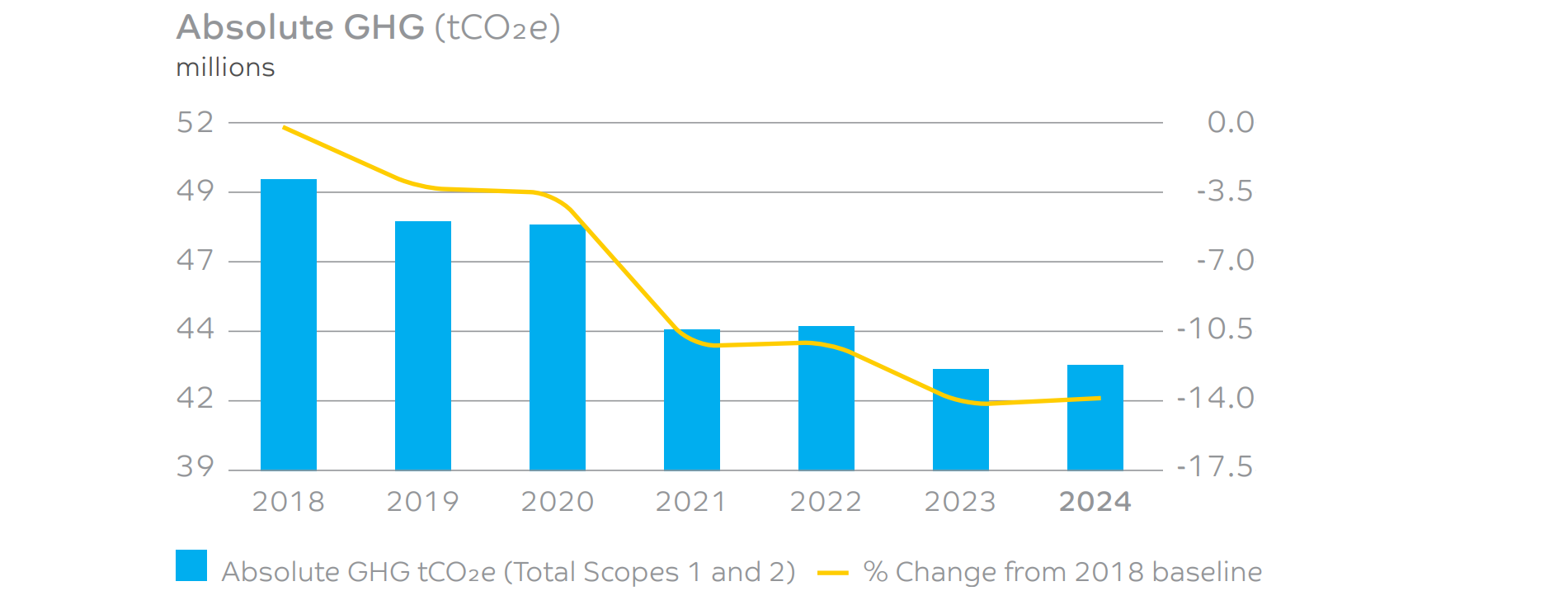SUSTAINABILITY AND RESOURCE EFFICIENCY
We remain committed to pursuing our carbon neutrality ambitions, while carefully navigating the economic and technological challenges that accompany this transition.
GREENHOUSE GAS INTENSITY
-
-22.7%
since baseline1
-
3.0%
2023-2024 change
Energy intensity
-
-15.6%
since baseline1
-
3.3%
2023-2024 change
Water intensity
-
-21.0%
since baseline1
-
4.7%
2023-2024 change
Material loss intensity
-
-56.3%
since baseline1
-
-6.7%
2023-2024 change
Flaring emissions
-
-49.9%
since baseline1
-
19.91%
2023-2024 change
Total CO2 utilization (Mn. T)
-
3.95
2024
Absolute GHG (total Scopes 1 and 2) (tCO2e)
-
-13.95%
since baseline1
-
0.4%
2023-2024 change
1Baseline: 2010
2Baseline: 2018
SABIC continues to strive toward its carbon neutrality aspirations while being cognizant of the challenges imposed by economic and technological dependencies. Our Carbon Neutrality Roadmap establishes the overarching vision for achieving this goal by 2050, with an interim target of reducing GHG emissions (Scopes 1 and 2) by 20% by 2030 from a baseline year 2018. Aligning with industry best practices, we are transitioning from an intensity-based approach to an absolute approach for our GHG emissions. While we will monitor intensity targets until the close of 2025, the roadmap supersedes this approach, shifting our focus to absolute targets (tCO₂e).
SABIC continues to focus on reliability and energy efficiency improvements as a crucial lever for our ambitions to reduce GHG emissions. Additionally, SABIC is committed to the Saudi Energy Efficiency Program (SEEP) in support of national energy efficient goals. In 2024, we progressed in the Saudi Energy Efficiency Center (SEEC) second cycle journey to bring energy efficiency and usage on par with global trends, and we have invested in multiple projects since the start of the cycle.
GREENHOUSE GAS EMISSIONS
SCOPES 1 AND 2
In 2024, emissions have been reduced by 13.95% compared to the 2018 baseline. On a year-over-year basis, 2024 emissions were slightly higher by 0.4%. Year-over-year GHG emissions related to Scope 1 were slightly down by 0.43%, while Scope 2 emissions were higher by 2.77% for the same period.

SCOPE 3
We aim to collaborate with our value chain partners on initiatives to reduce our indirect Scope 3 emissions. This includes adoption of low-carbon materials, optimization of logistics, energy, and carbon efficiency in processing and use of our products, and reducing end-of-life impacts. We previously reported Scope 3 emissions for categories 1 to 8, and we are now working with stakeholders to assess and align our Scope 3 emissions calculation approach and methodology for future reporting.
INTENSITY-BASED TARGETS
| Indicator |
|
Unit | Reduction target (2025) |
|---|---|---|---|
| GHG emissions | tCO2e/t sales | 25% | |
| Energy | GJ/t sales | 25% | |
| Water | m3/t sales | 25% | |
| Material loss | t/t sales | 50% |
GHG EMISSION INTENSITY
In 2024, GHG intensity reduced by 22.7% compared to the 2010 baseline. In 2024, GHG intensity rose 3.0% year over year due to planned maintenance and unplanned shutdowns.
GREENHOUSE GAS EMISSION INTENSITY (tCO2e/t product sales)
ENERGY INTENSITY
In 2024, energy intensity reduced by 15.6% compared to the 2010 baseline. On a year-over-year basis, the 2024 energy intensity was 3.3% higher due to planned maintenance activities and unplanned shutdowns.
Energy Intensity (GJ/t product sales)
WATER INTENSITY
In 2024, water intensity reduced by 21.0% compared to the 2010 baseline. On a year-over-year basis, 2024 water intensity was 4.7% higher due to maintenance activities.
Water Intensity (m3/t product sales)
MATERIAL LOSS INTENSITY
In 2024, material loss intensity reduced by 56.3% compared to the 2010 baseline. On a year-over-year basis, the 2024 material loss intensity was 6.7% lower, driven by improved reliability and waste minimization efforts.
Material Loss Intensity (t/t product sales)
Read more about our performance on our intensity-based targets .
Disclaimer: This abridged interactive version of the SABIC Integrated Annual Report 2024 is based on the original PDF report published on this website. In case of any discrepancy, the original PDF report will prevail.
